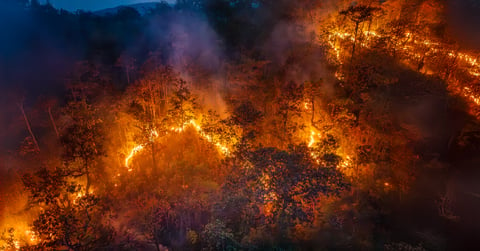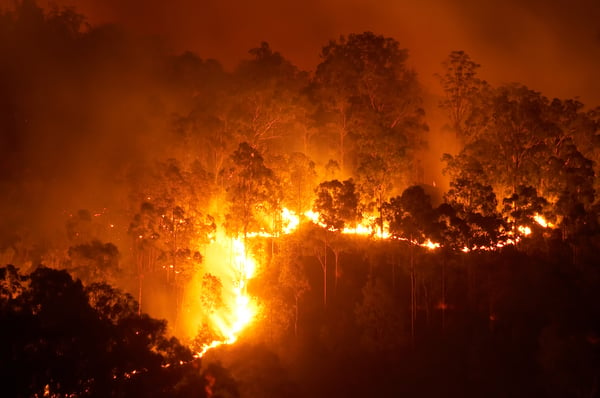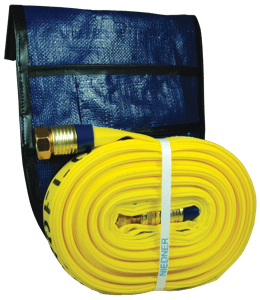
Wildfires have long been a natural part of the Earth’s ecosystem, but in recent years, their frequency and intensity have escalated, causing devastating impacts on the environment, wildlife, and communities.
Previous Wildfires
Three components are needed for a fire: fuel, heat, and oxygen. In nature, these fires can be catastrophic due to a combination of climatic conditions, human factors, and the availability of dry vegetation, leading to widespread destruction and consequential loss of life. Wildfires have become a prominent issue globally. Let’s take a look at some of the worst wildfires in recent years.
2023 Maui Wildfires
One of the deadliest wildfires in recent U.S. history, the Maui wildfires were fueled by strong winds from a distant hurricane combined with dry conditions. Approximately 2,000 acres were burned and 115 people were killed.
2023 Canadian Wildfires
Record-high temperatures and widespread drought conditions across Canada fueled the most destructive wildfire season ever recorded. More than 6,132 fires burned nearly 41 million acres.
2021 Siberian Wildfires
More than 100 fires burned across 3.4 million acres of northeast Siberia. Smoke from the wildfires reached the North Pole for the first time in recorded history.
2020 California Wildfires
California endured 8,648 wildfires in 2020. These fires burned 4.3 million acres, destroyed 11,116 structures, and killed 33 people. 2020 was the largest wildfire season recorded in California’s modern history.
2019-2020 Australian Bushfires
From June 2019 to May 2020, various regions across Australia experienced what became known as “Black Summer.” Fueled by extreme heat, drought, and high winds, the wildfires were among the worst in Australian history. A total of 45.9 million acres were burned, 3,500 homes destroyed, 3 billion animals were killed or displaced, and 33 people died.
These wildfires underscore the importance of robust fire management and prevention strategies to address and mitigate the impact of such disasters.
 Photo courtesy of iStock, Byronsdad
Photo courtesy of iStock, Byronsdad
Causes of Wildfires
While some wildfires are sparked by natural causes, many are the result of human activities. Some common causes of wildfires are lightning, unattended campfires, discarded cigarettes, and field fires from farm equipment.
Wildfires Due to Lightning
Lightning is one of the most significant causes of wildfires. These fires occur when a lightning strike ignites a tree or dry vegetation, particularly during periods of drought or in areas with low humidity. There are two types of lightning: cloud-to-ground and cloud-to-cloud, but it’s the cloud-to-ground lightning that often sparks wildfires.
When a lightning bolt strikes the ground, it can reach temperatures of approximately 53,540°F (30,000°C). This intense heat can instantly ignite dry grass, leaves, and other combustible materials. Wildfires caused by lightning are often challenging to predict and can spread rapidly, making them difficult to control.
While we cannot prevent lightning, we can mitigate its impact by maintaining healthy forests. Practices such as controlled burns and forest thinning reduce the amount of fuel available for a fire, thereby limiting its spread.
Unattended Campfires
Campfires are a beloved part of the camping experience, providing warmth, light, and a means to cook food. However, when not properly managed, they can become a dangerous wildfire hazard. Unattended or poorly extinguished campfires can easily ignite surrounding vegetation.
Some common mistakes with campfires include:
- Not dousing completely: Simply covering a campfire with dirt or sand is not enough. It needs to be thoroughly doused with water until the ashes are cold to the touch.
- Wind spread: Even small embers can be picked up by the wind and carried to nearby flammable materials, spreading the fire.
- Proximity to flammable materials: Setting up campfires too close to dry leaves, grass, or overhanging branches can quickly lead to unintended fires.
To prevent campfires from starting a wildfire it is important to always follow local regulations and guidelines. Never leave a campfire unattended, even for a short period. Keep water and a shovel nearby to extinguish the fire completely and ensure the fire is fully out before leaving the site.
Wildfires Due to Cigarettes
Carelessly discarded cigarettes are a leading cause of wildfires. A single cigarette butt, if not properly extinguished, can ignite dry vegetation, leading to potentially large and destructive fires.
Cigarettes can smolder for several minutes before igniting a flame, giving them ample time to cause major damage. In dry conditions, especially during the hot summer months, the risk is particularly high. Preventative measures that should be taken include disposing of cigarette butts in designated fireproof containers and avoiding smoking in high-risk areas such as forests and grasslands. It is also important to educate the public on the risks associated with improper disposal of cigarettes.
Field Fires from Farm Equipment
Farm equipment, such as tractors, combines, and other implementations, can inadvertently start wildfires. The hot exhaust systems and high engine temperatures can ignite dry crops and grass. Additionally, sparks from metal parts striking rocks or other metal objects can easily set fire to dry vegetation.
Strategies for prevention include regular maintenance of farm equipment to ensure it is operated efficiently and safely, installing spark arrestors on machinery, avoiding the use of equipment during the hottest parts of the day or in extremely dry conditions, and keeping fire extinguishers and water sources readily available in fields.
Dixon Forestry Fire Products
Dixon manufactures and supplies a diverse line of forestry products to assist with handling wildfires.
Forestry Fire Hose Non-Weeping
Features
- All polyester single jacket polyurethane lined attack hose
- Exclusive PU based color coating to aid abrasion resistance and color leaching
- Available in 50’ and 100’ lengths
- Impregnation: yellow
Specifications
- Proof pressure: 600 PSI at ambient temperature 70°F (21°C)
- Service test pressure: 300 PSI at ambient temperature 70°F (21°C)
- Working pressure: 270 PSI at ambient temperature 70°F (21°C)
- Forest Service Spec 5100-187
Forestry Mop Up Hose and Kit

Features
- Coupled with female and male brass ferrule type garden hose couplings
- Impregnation: yellow
- Consult Dixon for pricing and availability of other threads and configurations
Specifications
- Proof pressure: 300 PSI at ambient temperature 70°F (21°C)
- Service test pressure: 150 PSI at ambient temperature 70°F (21°C)
- Working pressure: 135 PSI at ambient temperature 70°F (21°C)
Forestry Grade Aluminum Ball Shut-Off Valve
Feature
- Hardcoated threads, acetal ball, and rigid inlet
Specifications
- Maximum operating pressure: 600 PSI at ambient temperature 70°F (21°C)
- Forest Service Spec 5100-238
Forestry Fog Nozzle

Features
- Maroon hard-coated barrel allows for easy identification
- Corrosion resistant plated
- Dual flow rate nozzles offer two straight stream and two fog patterns
Specifications
- Maximum operating pressure: 600 PSI (water only) at 70°F (21°C)
- Forest Service Spec 5100-239
Global Forestry Fog Nozzle
Feature
- Adjustable gallons per minute to allow firefighters to control the amount of water coming from the nozzle
Specifications
- Straight: 61 GPM at 100 PSI
- Fog: 105 GPM at 100 PSI
Bumpered Brass Fog Nozzles

Features
- Straight stream, capable of greater than 100° spray angle
- Twist shut-off and flow-type change
Specifications
- Maximum working pressure: 100 PSI
- Maximum rated pressure: 175 PSI
Pick Head Fire Axe
Features
- Axe blade for cutting
- Pick for prying
Specification
- 36” hickory handle
Forged Forestry Couplings: Male and Female
Feature
- Common quarter turn sexless head (a 1-1/2” QT fitting will mate with a 3/4” QT or 1” QT)
Specification
- Maximum operating pressure: 300 PSI at ambient temperature 70°F (21°C)
Quick Connect Forestry Expansion Ring Couplings
Feature
- 1-11/16” bowl size forged aluminum construction
Specification
- Sold in sets of (2) with expansion ring
Forestry Hose Clamp & Spanner
Features
- Offset handle enables the user to easily operate the clamp while wearing gloves
- When clamped onto the hose the brass locking device safely holds the clamp in position, a spanner is an integral part of the clamp
Specifications
- To be used with lightweight 1” and 1-1/2” hoses for pressures up to 200 PSI
- Forest Service Spec 5100-245
Summary
Wildfires are a multifaceted problem influenced by both natural elements and human activities. Understanding the causes of wildfires — whether from lightning, unattended campfires, discarded cigarettes, or farm equipment — can help us take proactive measures to prevent them. By fostering awareness and implementing stringent safety practices, we can reduce the occurrence of wildfires and protect our natural landscapes and communities from their devastating effects.
For more information on Dixon’s fire protection solutions, visit dixonvalve.com or call 877.963.4966.









